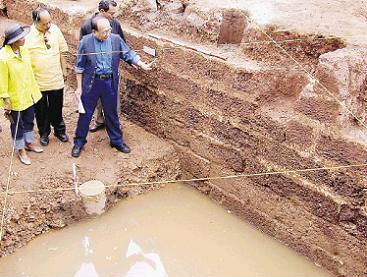 2006/12/04 Ancient fort likely to knock down tower plan
2006/12/04 Ancient fort likely to knock down tower planThe Malacca Tower will most likely be relocated following the discovery of an ancient wall on its project site.
Work on the RM21 million project has been ordered to stop following the discovery of the ancient fort known as the Bastion Middlesburgh, which is part of the Fortaleza DíMalacca (Malacca Fort), built after the Portuguese captured Malacca in 1511.
The relocation will be enforced under the Heritage Act 2005 which prevents any modern project to be implemented without taking into account historic and heritage findings.
 |
|
| Datuk Seri Dr Rais Yatim (in blue) inspecting the site yesterday. | |
An elated Culture, Arts and Heritage Minister Datuk Seri Dr Rais Yatim said everything pointed to the tower being relocated.
"This is an historic finding, which will bring immense benefits to Malacca and the country."
"For the first time, we will be able to determine history more accurately through this discovery."
"The ministry and the Malacca government will conduct an in-depth study of the wall. The findings will be presented to the Cabinet," he said after a site visit yesterday.
Rais said Heritage Commissioner Professor Datuk Dr Siti Zuraina Abdul Majid had been instructed to give the discovery priority, namely to unearth the structure and rebuild it, if possible.
"The study will determine the exact size of the fort. Emergency funds will be approved for research works on the structure."
Rais has suggested that the entire fort area be cordoned off but said the final decision rested with the state government.
He added, the wall, which would enrich Malaccaís historical heritage could be turned into a tourist attraction.
Archeologists from the Malacca Museum Corporation, Museum Department and National Heritage Department have also found several artefacts, including ceramics, at the site.
Rais said he would seek Cabinet approval for funds to conduct a comprehensive study on the Malacca Fort, with the view of reconstructing some of the vital portions of the structure.
"But for this, we need expert advice and this includes working with the Portuguese, historians, heritage enthusiasts and other parties who might have information on the structure."


Most recent articles:
[an error occurred while processing this directive]






